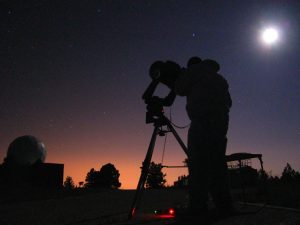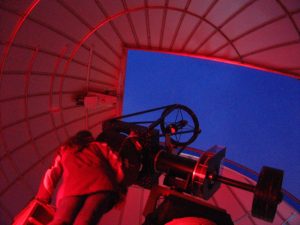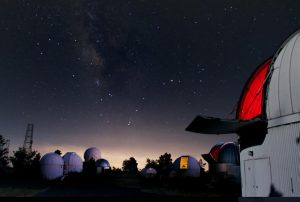 Since 1988 Arizona’s Astronomy Camp has located within the dark skies of Southern Arizona, provided students of all ages the ability to explore “the heavens” with large telescopes and experience the excitement of scientific inquiry.
Since 1988 Arizona’s Astronomy Camp has located within the dark skies of Southern Arizona, provided students of all ages the ability to explore “the heavens” with large telescopes and experience the excitement of scientific inquiry.
Located at the University of Arizona’s Mt. Lemmon Observatory, Astronomy Camp provides unique opportunities to explore the skies and the environment in general. Each Camp is an “immersion” experience combining all four STEM letters: Science, technology, engineering, and numerical thinking (“math”). The staff emphasize a hands-on learning approach with activities driven by student involvement and interest. A prior background in astronomy is not required.
The Astronomy Camp team is hosting two camps for teenagers in June, a beginner’s camp June 10 – 16 and an advanced camp June 19 – 26. The beginning camp is for those who haven’t completed either geometry or algebra II. It introduces students to astronomy, engineering and physical sciences. Advanced camp is for students who have completed the math requirement and will concentrate on their own research projects.
These “science camps” are available internationally to both teenagers and adults. The camp structure is designed to motivate all students to further their education in science, math, engineering, and technical fields, not necessarily to become scientists. To encourage all interested students to explore science and broaden their minds, need-based scholarship opportunities are available! We are proud that former Campers earned advanced degrees in a wide variety of disciplines and that many others, including our staff, have become leaders in their fields.
 Astronomy Camp offers an opportunity for both young and old to experience the universe in new and exciting ways. Teenage students gain a cosmic perspective of the earth and themselves. The camp allows students to examine career alternatives and reinforces school lessons through real scientific and engineering applications and investigations. With the wide range of topics incorporated into the Astronomy Camp curriculum, it is much more of a science camp than purely star gazing.
Astronomy Camp offers an opportunity for both young and old to experience the universe in new and exciting ways. Teenage students gain a cosmic perspective of the earth and themselves. The camp allows students to examine career alternatives and reinforces school lessons through real scientific and engineering applications and investigations. With the wide range of topics incorporated into the Astronomy Camp curriculum, it is much more of a science camp than purely star gazing.
At night, Campers observe a plethora of celestial objects under dark skies. They become astronomers, operating research-class telescopes, keeping nighttime hours, interacting with leading scientists, interpreting their own observations, and investigating their own questions about astronomy and the universe. Depending on the specific event, Campers use telescopes on Mt. Lemmon, such as a 12-inch Meade LX-200 telescope, the 61-inch Kuiper telescope, and the 24, and 32-inch telescopes on Mt. Lemmon. By the end of Camp all Campers are intimately connected with some of the most advanced technology available for cosmic discovery.
 Campers have an amazing array of unique tools to help them explore their universe. All telescopes can be equipped with a selection of instruments, including 35mm cameras, digital cameras, a photometer, three CCD cameras, two CCD spectrometers, and specialized equipment for detailing imaging of the Sun. The Advanced Camps feature access to professional instruments for imaging at visual, infrared, and radio wavelengths with large format CCDs and HAWAII (1024×1024 pixel) electronic cameras. A complement of computers allows campers to analyze data using professional languages (IRAF, IDL, and others) and to simulate astronomical phenomena.
Campers have an amazing array of unique tools to help them explore their universe. All telescopes can be equipped with a selection of instruments, including 35mm cameras, digital cameras, a photometer, three CCD cameras, two CCD spectrometers, and specialized equipment for detailing imaging of the Sun. The Advanced Camps feature access to professional instruments for imaging at visual, infrared, and radio wavelengths with large format CCDs and HAWAII (1024×1024 pixel) electronic cameras. A complement of computers allows campers to analyze data using professional languages (IRAF, IDL, and others) and to simulate astronomical phenomena.
During the daytime, internationally known scientists speak on current scientific topics, including the latest NASA space missions. Students also build crystal radios, dissect cameras, explore the diverse geology and ecology though hiking, outdoor demonstrations, and travel between mountaintop observatories. The Camps also incorporate Space art and musical interpretations of scientific processes. All Camps include an in-depth tour of The University of Arizona’s Mirror Laboratory, now producing not only the world’s largest telescope mirrors with 8.4-meter diameters but also some of the most advanced large-format optical designs for telescopes to date.
Perhaps the most unique aspect of Astronomy Camp is the availability of large research telescopes under dark Arizona skies. At the Mt. Lemmon and Bigelow sites (9,157 and 8,235 feet elevation) students have access to:
– A 12-inch (0.3 meter) Meade LX-200 reflector.
– The 24- and 32-inch telescopes of the SkyCenter.
– A 60-inch and the 61-inch Kuiper telescope.
– A 60-inch telescope of the University of Minnesota, enabling digital imaging at infrared wavelengths with a 2MASS IR camera.
At the Kitt Peak site (6,875 feet elevation) students utilize:
– The 90-inch Bok telescope
– The 12-meter radio telescope of the Arizona Radio Observatory
At the Mt. Graham site (10,500 feet elevation), Advanced Teen campers will use:
– The 10-meter Heinrich Hertz Submillimeter Radio Telescope
Astronomy Camp also has a large array of imaging instruments that can be installed on the available telescopes. These include:
– Santa Barbara Instrument Group ST-6B (375×242 pixels), ST-7XE (765×510 pixels) and ST-9XE CCDs (512×512 pixels) for all telescopes. The ST-7E camera at the 12-inch LX-200 telescope is equipped with a ten-position filter wheel and can be used with an f/3.3 focal reducer to provide a field-of-view of 20 arcminutes. It can also be used with an AO-7 adaptive optics system.
– 35 mm camera mounts and digital SLR cameras for astrophotography on all telescopes
– Photon-counting aperture OPTEC SSP-3 photometer, for all telescopes
– Several 1.25″ and 2″ eyepieces (including a 55mm Tele Vue Ploessl and a 35mm Tele Vue Panoptic), filters (nebular, solar, lunar) for all telescopes.
The following instruments are available for the Advanced Camps:
– PISCES: A 1024×1024 pixel wide-field near-infrared (1.0-2.5 microns) camera, still used for active research, can be used at the 90″ telescope for Advanced Camps!
– Infrared imaging with a 2MASS IR camera on the 60-inch telescope of the University of Minnesota.
– A world-class 4096×4096 pixel CCD for imaging at the 61″ Kuiper telescope
– A state of the art 4096×4096 pixel thinned-CCD prime focus camera at the 60″ telescope that covers a one-degree field of view (4 full moons).
Astronomy Camp also features an afternoon of solar imaging with a wide variety of gadgets for safely viewing the Sun’s photosphere, chromosphere, sunspots, prominences, and flares. These include:
– A Day Star hydrogen-alpha filter for observing prominences, flares, granulation, and general activity on the Sun. Its bandwidth is 0.6 Angstroms. It can be used on the 12-inch LX-200 telescope or separately on an 8-inch Celestron telescope.
– A Coronado Instruments Ca K filter for observing solar magnetic activity.
– A Sun Gun for directly imaging the Sun in broad-band visible light.
– A classic Questar 3.5-inch telescope for solar imaging.
– Two models of SunSpotter telescopes.
– BinoMite binoculars from Coronado.
– Two Astroscan telescopes for viewing the photosphere by eyepiece projection.
– Spectroscopes for examining the Fraunhofer absorption lines in the Sun’s spectrum.
– Pinhole cameras using the dark interiors of our telescope domes.
– Eclipse glasses for direct viewing of sunspots.
The “other” half of observational astronomy is spectroscopy. Using the Camp spectrometers, campers can dissect the light coming from astronomical objects to determine their physical and chemical properties! Technology available includes:
– An Optomechanics Research grating spectrometer, for all telescopes. It can be used for visual spectroscopy (by eye), for photographic spectroscopy (with a 35mm camera), or CCD spectroscopy (with the ST-9XE or ST-6 CCDs).
– An SBIG Model SGS spectrograph and ST-7XE CCD for use on the 12-inch LX-220 telescope.
– Diffraction gratings (“grisms”) from Rainbow Optics that thread into 1.25″ eyepieces, mostly for visual use on our 4″, 8″, and 12″ telescopes.

